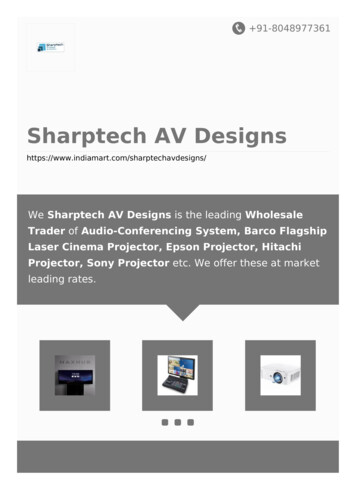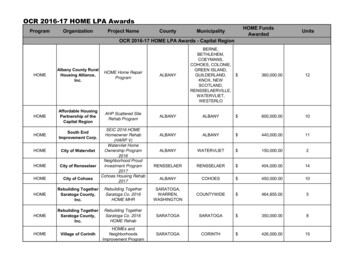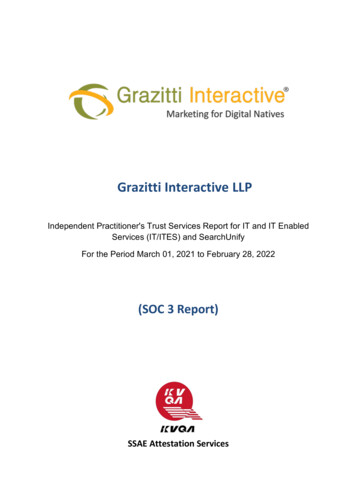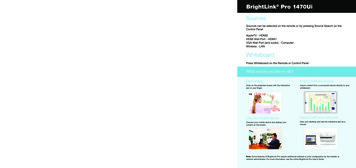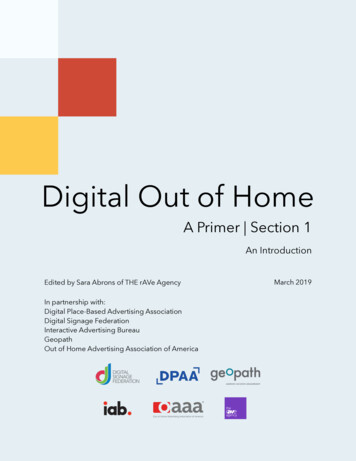
Transcription
Title pageDigital Out of HomeA Primer Section 1An IntroductionEdited by Sara Abrons of THE rAVe AgencyIn partnership with:Digital Place-Based Advertising AssociationDigital Signage FederationInteractive Advertising BureauGeopathOut of Home Advertising Association of AmericaMarch 2019
Table of Contents: Section 1What are digital signage and digital out of home?3Ecosystem (Players)3Environment Types6Interactive Technology9Audience10Market Growth10Effectiveness11Data & Privacy12Ad Buying Overview13Extensions & Interactivity15Developing a Needs Analysis16
What are digital signage and digital out of home?Digital signage is everywhere you look. It’s the digital billboard you drive by when you’re onthe highway. It’s the display at the airport that tells you what gate your flight is leaving from.It’s the digital menu board you look at to see what’s available to order from the counter of arestaurant. It’s the digital touch screen map that helps you know how to get around a mall. It’seven the black and white display running along the shelves of the grocery store that showsdynamic pricing for the items displayed. Digital signage is any digital display not in a privatearea that provides information and that’s not personal to you. (The TV at your house? Notdigital signage. Your cell phone or personal tablet? Not digital signage. The monitor for yourcomputer at work? Not digital signage.)The concept of digital signage can be confusing -- it’s clouded by the overabundance ofterms describing it: digital out of home (DOOH), captive audience networks, in-store media,video advertising networks, narrowcasting and audiovisual signage, to name a few of themore popular references.So how do we actually define digital signage? Digital signage is a network of digital displaysthat is centrally manageable and addressable for targeted information, entertainment,merchandising and advertising.DOOH stands for Digital out of Home. Although it sounds like it might be the same thing asdigital signage, and is often used interchangeably, it’s actually more specific. DOOH refers todigital displays outside of the home that have advertising and can have their advertisingcontent changed remotely using digital technology. In a nutshell, all DOOH is digital signage,but not all digital signage would be considered DOOH.Digital signage can be an extremely effective and affordable communications medium forbusinesses and institutions of all types and sizes. And although not all digital signage hasadvertising, DOOH and the opportunity for advertising are major drivers of the growth of thismarket.Ecosystem (Players)The current state of the digital signage market has evolved in a complicated way. Large scalemessaging, OOH (out of home) advertising and really anything that used to be on paper cannow be more conveniently shown on a display. This transition to digital has happened in a3
short amount of time. Printed billboards and outdoor advertising posters went digital.Corporate communications via bulletin boards and memos went digital. Restaurant menuboards went digital. Retail store imaging went digital.Unfortunately, the transition to digital happened without any industry standards or uniformapproaches, which has led to fragmented technology and platforms. There are many differentplayers doing the same things but in slightly different ways, using slightly differentterminologies and methods of getting things done, some of which are incompatible. Inrecent years, the market has consolidated and standardized a bit, with more companies andtechnologies working together, but there are still many different players that you shouldknow.Network owners -- for whom this guide is written -- are those who own or operate a networkof displays (or potentially a single display) that are in public spaces. That could includeowners of digital billboards, a retail store or grocery store owner with displays at one ormultiple locations, a university, a hospital, a hotel, an airport or any number of organizationsthat have public or semi-public locations with displays, or that could have displays, withmessaging on them.There are numerous technology providers. There are manufacturers that make a range ofrelevant hardware, including displays (of which there are many types), media players (whichare sometimes just computers), mounts, kiosks, networking hardware. There are alsomanufacturers of software that create, manage and schedule content (called ContentManagement Systems or a “CMS”). Sometimes the CMS software is bundled with mediaplayers, and sometimes players are embedded inside displays. There are many differenthardware and software configurations.Digital signage CMS platforms can not only schedule and manage content, but many can alsocreate the content. Most come with templates and plug-ins to allow a network owner tocreate content in-house, even without a design expert on staff. Many CMS platforms aredesigned for specific digital signage network types, with the scheduling and content featuresgeared for that application, including ones that specialize in digital signage for educationalinstitutions, retail environments or hotels -- but there are many possibilities. There are alsocompanies that specialize in digital signage content design and management.There are companies that design, manage and support the systems once they are installed.Installation and design is often done by an outside company that specializes in digitalsignage, such as an AV integrator or IT company. This is one way network operators can buy asystem. Big network operators sometimes buy directly from a manufacturer, who can bring ina team to design and install the system if the sale is large enough.4
Any network owner that wants to include advertising as part of the content needs tounderstand the many players in this part of the industry as well. Many networks are entirelyad-based, but there are other networks that only have advertising part-time, or need toconsider advertising as a revenue source even though the main purpose of the network isanother type of communication. Many network owners rely on advertising revenue to pay forthe costs of putting in and maintaining a network, even if there’s other content on thenetwork. A good example is companies that install free wayfinding kiosks on city streets thathelp pedestrians find their way around or to points of interest. The company that installs thenetwork of displays sells ads and shares revenue with the city, which gets the benefit of thewayfinding system and some extra money without having to pay anything up front.The network owners can sell ads themselves, hire an outside company or person (a salesrepresentative or sales rep firm), partner with another company that deals with the advertisingside or do it all using software. There’s software that helps manage, serve and track ads. This isoften a part of a CMS, but not always. On the other side, there are advertisers and the peoplewho represent them -- ad buyers, ad agencies and media planners.The process of selling and buying DOOH advertising can now be automated on both sidesvia programmatic advertising platforms. Programmatic advertising is simply the automatedbuying and selling of advertising based on data and computer systems. Sellers use an SSP(Supply Side Platform) to make their DOOH advertising inventory available to multiplebuyers. Buyers use a DSP (Demand Side Platform) to place ads across multiple media ownersand environments simultaneously. In between these platforms is an ad exchange, which isbasically an auction-driven marketplace for digital advertising inventory. DOOH is nowavailable on ad exchanges that sell multiple kinds of digital ad space, allowing DOOH ads tobe bought and sold on a large scale alongside mobile ads, Internet display ads, paid socialmedia and many other kinds. The cross platform integration is key here, because the ability tosee the value of audiences reached by DOOH, in the context of all other digital audiences anadvertisers wants to reach, is what is allowing the DOOH market to grow and scale.Because advertisers need data to decide where to place ads and how much to pay, there’salso a whole industry around the collection of audience and impression data. There areseveral organizations that collect audience location data across a wide range of media andlocations, such as Geopath (non-profit and specializing in OOH -- out of home -- advertisingaudiences) and Nielsen (private, global measurement and data analytics company well knownfor radio and television audience measurement). The Media Rating Council (MRC) wasestablished by the U.S. government in the 1960s to improve the quality of audiencemeasurement. It now works with numerous organizations in the OOH space, includingGeopath, to establish standards and protocols for measurement of OOH audiences.5
There are numerous companies that analyze a range of audience data to provide furtherinsights beyond impressions. Location data from mobile devices (GPS, cellular, etc.) andtechnologies that work with it have been very helpful in tracking and analyzing metrics in thisspace, providing previously unavailable insights into consumer behavior and how peopleengage with brands that advertise on OOH and DOOH displays. There are also nownumerous types of advanced technologies that leverage cameras, computer vision andartificial intelligence to “see” people and things in front of OOH and DOOH displays andmake observations about what is seen. Facial detection software can detect people in spacesand report on whether they look at a display and for how long, as well as demographic dataabout those people (age, gender, etc.).As you can see, there are numerous players in digital signage, all offering different types ofhardware, software, analytics and data, support, content design and services. It can beoverwhelming, but there are many companies offering turnkey networks, including hardware,software, support, maintenance, content and audience analytics. Who you engage to helpyou depends on your goals, resources and budget. Further below is a needs analysis that willhelp you.Environment TypesEnvironmentalClassificationDefinitionShopping MallIndoor or outdoor shopping area traditionally considered a "mall"Shopping CenterSmaller shopping facility in which a group of stores tend to face the parking lotLifestyle CenterMulti-use shopping facility of retail/offices/housing/etc.Outlet MallShopping facility with large parking areas and overflow stores, often outdoorwithout a food courtFood CourtFacility with multiple food vendors and a common seating areaRetailStore selling one or multiple types of products, in which shoppers spend amoderate amount of timeGrocery StoreStore mainly specialized in distribution of groceriesConvenience StoreLocation that offers a variety of goods for purchase -- usually a quickshopping experience such as the store in a gas station or a bodegaBarFacility where the majority of patrons go for the purpose of drinking6
EnvironmentalClassificationDefinitionSit-down RestaurantDining facility where the majority of patrons sit at a table to order foodQuick-ServeRestaurantsDining facility where patrons order food from a counter then sit or leave to eat,or sometimes go through a drive-throughTransit HubA multi-modal transportation stop; usually multi-platform and allowspedestrians to transfer between trains, busses, streetcars, light rail, etc.Transit StationA stop along a transit line that is unique to one mode of public transportationAirportRegional, international or private airportOffice BuildingMulti-business office buildingBusinessSingle business officeTheaterSingle or multi-auditorium venue for watching movies/plays/musicals/etc.CasinoGambling facility and associated hotel if one existsHotelHotel, motel or resortStadiumSports stadiumIndoor RecreationIndoor location where patrons spend leisure time but do not necessarily buyanythingOutdoor RecreationOutdoor location where patrons spend leisure timeAcademic BuildingClassroom building or library (universities, as well as primary and secondaryschools)Institutional HousingHousing designed for temporary useStudent CenterCollegiate building designed for multiple purposes such as dining, studyingand shoppingSpiritual CenterPlace of worshipGas StationGas StationRest StopFacility along roadway for stopping, often with food, gas and convenienceshoppingDOOH is typically divided into two categories that address audience types:7
Large-format displays are seen by large and varied audiences, typically in public areaswhere pedestrians and/or vehicular traffic are passing by. Examples include highwaybillboards, ads on buses or the outside of other moving vehicles and street furniture, whichare displays along sidewalks such as those on benches and bus shelters.Digital place-based media are digital displays in destination locations -- places people aregoing for a reason other than seeing the display (as opposed to, for example, a movietheater). The audiences are more specific than large format displays, because the content canbe related contextually to the place that the audience is and their reason for going there.These include displays in airports, on university campuses, inside taxis, in restaurants andbars, in retail stores, in doctors’ waiting rooms -- the possibilities are endless.Digital signage can also generally be categorized in other ways that address the uniquechallenges of specific environments.Outdoor (Outside)Outdoor digital signage has different technology challenges than indoor environments.Displays must be visible even when there’s a lot of ambient light, such as direct sunlight, sothey have to be bright. The hardware has to be able to withstand heat, cold, dust, water andmore, depending on the environment.Examples: Drive-through restaurant menu boardsOutdoor electronic billboardsOutdoor wayfinding displaysDigital street signsStreet furnitureIndoor (Inside)Indoor environments offer more flexibility than outdoor environments for digital signage, asthe weather, temperature and vandalism concerns are mitigated. Indoor environments varygreatly, and present opportunities to use a wide array of display types, sizes and shapes tomeet particular use cases. With this in mind, the most important consideration is generallycontext. Decisions must be made that balance objectives, available space and the ambientenvironment. Teams must think through a number of concerns including: Ideal spots to install Viewability based on behavior near the display The use (or non-use) of audio8
Number and genre of competing/complementary messages around it (particularly in astore) What type of content will enhance the value for the viewer Typical viewer dwell time Cost and complexity regarding power provision and proper mounting Network/display connectivity Ability and methods to properly measure traffic and engagementSmall format (Inside)Small format displays present less technical challenges than large format ones, since you’lltypically just be picking the size of the flat panel display you’re going to use. A single flatpanel display wouldn’t typically be larger than 110” (measured diagonally), which is currentlyabout the largest display of that type that can be manufactured. Most of the time you stillwouldn’t use a single display that big, because it would be more cost effective to build a smallvideo wall with smaller displays.Examples: Doctors’ office waiting roomsIndoor digital menu boardsSingle displays in retail storesCorporate communicationsIndoor kiosks for wayfinding or informationLarge format (Inside)When it comes to large-format displays, there are more decisions to make, and they havedifferent trade-offs. For large format displays, options include video walls composed of eitherflat panel displays (LCDs or OLEDs) or direct-view LEDs, as well as projection.Examples: Flight information displays (arrival and departure boards) Indoor digital billboards Some retail store displaysInteractive TechnologyInteractive displays have touch technology incorporated as part of the solution. Projectioncan technically have touch incorporated using IR or other types of sensors on the projection9
surface, but most digital signage applications that need touch will be flat panel displays,either single displays or video walls. Direct-view LED displays would not be used in a touchapplication. Touch technology can be added to a display using a touch overlay, or beincorporated directly into the display technology. It can work in both indoor and outdoorapplications.Examples of applications that might use touch: Public information displays that require user control to navigate menusRetailInfotainment type displays, that entertain and inform a user at the same timeWayfinding kiosksAudienceSo who sees your content? The audience, and what information they need or you want tocommunicate to them, should be a primary consideration when considering how to buildyour digital signage network and how you design your content.Audience measurement will be a key part of your network’s success, and is especially critical ifyour network or display has advertising. Advertisers need information about your audience sothey can decide if they want to buy and display ads on your network, how much they arewilling to pay for them and what content they should put in their campaigns to target them.There are numerous ways to measure audiences, which are explained in another part of thisdocument. Standards for audience measurement should be followed by network owners -this is very important to ad buyers, who need to be able to compare consistent metrics acrossmany different networks and places.Market GrowthConsumers are more mobile than ever -- increasing the visibility of out of home media. Thegrowth of mobile usage correlates to Americans spending about 70% of their time outside ofthe home, an increase of 50% over the past two decades, according to research by theOAAA. 60% of consumers’ digital media time is now spent on smartphones, tablets and apps,according to Comscore’s “2014 U.S. Mobile App Report.” The rise of the mobile consumerhas expanded marketers’ ability to connect with audiences across multiple touch points.10
Out of home (OOH) advertising revenue is now 7.7 billion, based on figures released by the(OAAA). The revenue total marks a record all-time high for OOH with 31 consecutive quartersof growth since the most recent recession.Almost 4.5 billion is expected to be spent on DOOH advertising by 2019 in the UnitedStates, which is an increase of 1.2 billion since 2016. According to an article in Adage,“Zenith forecasts that DOOH will grow faster globally than all other buying methods, andPricewaterhouseCoopers predicts that DOOH advertising revenues will overtake traditionalmedia spend in 2020, growing at a rate of 15% a year for the next four years.”The global digital signage market as a whole is expected to grow from 20.74 billion in 2017to 31.62 billion by 2023, at an estimated CAGR of 7.28%, according to a report by OrbisResearch.EffectivenessDOOH has shown itself to be a very effective medium for communication and for advertisers.In a 2010 study by Arbitron, 70% of U.S. residents (aged 12 or older) reported seeing a digitalvideo display in a public venue in the last month, and 52% recall seeing one in the last week.The same study reported that 47% of those who had seen a digital place-based video in thepast month specifically recalled seeing an ad, and 19% of those say they made an unplannedpurchase after seeing an item featured in the ad. A recent InfoTrends study said that digitaldisplays offer 47.7% effectiveness increase on brand awareness and increase the averagepurchase amount by 29.5%, as well as generate a 32.8% growth in repeat buyers. 42% ofshoppers have said they would prefer to shop in a store with in-store video displays, andretailers with digital signage displays experience a 31.8% (average) increase in sales volume.A study published in 2015 by Nielsen showed that 75% of respondents reported seeing adigital billboard in the past month and 60 percent in the last week. 55% of those were highlyengaged, recalling the message on the display. 82% recalled advertisements in the lastmonth with 35% noticing AMBER Alerts or missing child reports and 18% noticing weatheralerts. In corporate communications, digital signage displays capture 400% more views thanprinted displays.According to a Hospitality Tech study, 38% of those surveyed said they’d be more likely todine at a quick service restaurant that offered a self-service option, and 41% said they’d bemore likely to stay at a hotel that had a self-service check-in / check-out kiosk.11
As an advertising medium, DOOH offers advertisers the opportunity to reach broadaudiences and have high-impact campaigns. Unlike other types of digital advertising, thereare no ad blockers and no click fraud. Technology has allowed for improvements in audiencemeasurement and impression analytics.And audiences like them! The statistics show that people like digital displays and seek outplaces that have them. They like completing transactions (even in less traditional ways) ondigital displays. They are more likely to look at messaging on a digital display than a printedone. They remember the information they see on them and have higher brand recall whenthey see ads on digital displays.Digital signage communications has many advantages over printed communications -- it’sfaster, easier and less expensive to change. It’s scalable. Much of the process can beautomated. It offers many benefits to the companies that want to communicate -- and it’s clearthat audiences like it too.Data & PrivacyGuiding Principles Regarding Privacy and the Use ofConsumer DataPrivacy and Consumer Data Usage Guiding Principles are recommendations intended toprovide baseline markers that respect consumer privacy and the use of consumer data.Recognizing that the operational characteristics of DOOH practitioners often differ from oneanother and technology itself changes rapidly, the following guiding principles anticipateindividual companies may need to adopt modifications that are consistent with particularbusiness models.1. Privacy by Design: DOOH practitioners take privacy into account in the entireengineering process to develop products that anticipate and mitigate any privacyconcerns.2. Transparency Is Critical: Consumer data collection practices should be transparentand accurately disclosed.3. Legitimate Purpose: DOOH practitioners only collect consumer data for specific,explicit and legitimate purposes.4. Compliance with Laws: The collection and use of consumer data must comply with allapplicable laws.5. Individual Control: Consumers should have control over whether to disclosepersonally identifiable information.12
6. Protection of Personally Identifiable Information: DOOH practitioners should takereasonable precautions to protect personally identifiable information in theirpossession from loss, unauthorized access or theft.The Impact of Privacy LawsThe General Data Protection Regulation (GDPR) was recently enacted in the European Union(EU) related to the data protection and privacy for all individuals within the EU. It alsoaddresses the export of personal data outside the EU. The GDPR aims primarily to givecontrol to individuals over their personal data and to simplify the regulatory environment forinternational business by unifying the regulation within the EU.The regulation contains provisions and requirements pertaining to the processing of personaldata of individuals inside the EU, and applies to any business established inside or outsidethe EU, processing personal data of people inside the EU.GDPR provisions are encouraging lawmakers to consider similar regulations in other regions,most notably the recently adopted California Privacy Act which reflect many aspects of GDRP.These laws pertain to the collection, storage and use of personal consumer data bycompanies.DAAThe Digital Advertising Alliance (DAA) establishes and enforces responsible privacy practicesacross the advertising industry, providing consumers with enhanced transparency and controlthrough multifaceted principles that apply to multi-site data and cross-app data gathered ineither desktop, mobile web or mobile app environments. The DAA is an independent nonprofit organization led by leading advertising and marketing trade associations. Both IAB andOAAA are members of DAA.Ad Buying OverviewWhen planning the deployment of a DOOH network (networks that are completely ad-basedor a mix of ad content with non-ad content), you must take into consideration how you willsell ads to buyers, and how they will buy them from you.Advertisers typically buy ad space from media platforms in one of three ways: directly fromthe media platform / network itself, via an agency or using technology that automates thebuying of ads such as an ad buying platform or programmatic buying via a DSP (demand sideplatform). Sometimes a network will have a mix of ads purchased in different ways -- think of13
when you watch a television broadcast on a local TV channel -- you’ll see ads from large,national (or international) companies, which you could find on various TV stations across thecountry, and also local businesses in your area that are sold by the local TV station, oftenproduced by that TV station itself. Network owners also have choices -- they can sell ads usingan in-house sales team, using a rep firm or using technology such as an ad network exchangeor SSP (supply side platform).When a network owner sells ad space directly to advertisers, they form a direct relationshipand must negotiate together all the terms of a campaign -- how often the ads will run and forwhat length of time, how long the campaign will be, what the price will be, how many otherads can be shown in the same spot, who the audience is and how to target them, etc. Theywill do this using an in-house sales team or a sales rep person or firm.Sometimes ad buyers may work with an agency that negotiates directly with network ownersto purchase ad space. The agency will negotiate all the terms of the campaign on behalf ofthe advertiser, typically for a percentage of the total ad spend. Larger ad buyers, and evenmany smaller ones, will frequently use agencies, so all DOOH network owners shouldbecome familiar with how agencies work, how they make money and what they require towork with them successfully.Finally, ad buyers can buy ad space across multiple platforms and networks throughprogrammatic technology. Programmatic is technology that automates the ad buying andselling process, offering efficiency and speed that allows the sales process to scale. The abilityto scale DOOH campaigns is critical to its success as an advertising medium and ability toincrease its share of advertising revenue.While there will always be unique publishers, media outlets and venues that advertisers willpursue regardless, increasingly ad buyers are relying on software, data and technology thatlets them buy ad space on a large scale based on their desired audience (and otherparameters) -- and not because of a relationship with a media or network owner. Standardsallow for re-use of creative materials. This means that a single ad buyer could purchase adspace and deploy one set of creative materials to potentially thousands of locations andnetwork types, from cell phones to websites to DOOH -- in a very short time frame. Networksthat don’t work with programmatic platforms on the sales side are missing out on ad revenuepurchased this way.On the buying side, buyers use a DSP (Demand-Side Platform), which automates the processof buying, serving and tracking ads. All the data (supplied by the network owners orpublishers from the other side of the platform, called an SSP -- Supply-Side Platform) isavailable there and can be looked at as part of much larger buying and media planning14
decisions. The ad buyers can buy the ads with what’s called Real Time Bidding (RTB), in whichthey bid against other ad buyers for available ad space. They can also go through a processcalled programmatic direct, in which qualified buyers (often agencies) are granted access to aprogrammatic network and can buy directly from the network. The difference is thatprogrammatic direct gives an ad buyer more direct insight into the specific audience of thenetwork its buying from. Using RTB, ad buyers bid based on parameters they set and willhave less specifics about the networks their ads actually show up on. Both are sold in a costper thousand views (CPM) pricing structure, and the views from programmatic direct aretypically more expensive, due to the additional information provided on the network and itsaudience, the views are more valuable.Most network owners can be successful utilizing a mix of local inventory, sellingprogrammatic direct and RTB sales. No matter what route you choose, it’s important that youconsider how you want to sell ads at the beginning of your network implementation process,so you can make sure you have the necessary resources set up for that strategy, particularly ifad revenue is an essential part of your network’s success.Extensions & InteractivityAs it becomes increasingly challenging to reach today’s consumer in the fragmented medialandscape, the effectiveness of DOOH advertising has become more significant to brandmarketers. There are a variety of digital marketing avenues that can be used in conjunctionwith a DOOH campaign to extend the reach and impact of the campaign, driving measurablebehaviors such as app downloads, social interaction and content generation, almost allthrough users’ mobile devices.When combined with other advertising as part of an integrated media plan, OOH has beenshown to extend reach and drive consumers to engage with brands online and in-store. A2
Programmatic advertising is simply the automated buying and selling of advertising based on data and computer systems. Sellers use an SSP (Supply Side Platform) to make their DOOH advertising inventory available to multiple buyers. Buyers use a DSP (Demand Side Platform) to place ads across multiple media owners and environments simultaneously.

